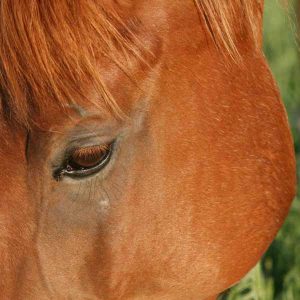
Tetanus: Is Your Horse at Risk?
Fifty to 75 percent of the horses that contract tetanus will die, no matter what treatment is administered. Luckily, due to the availability of effective vaccines, horse owners can easily protect themselves and their companions from this deadly disease.
Tetanus, commonly called lockjaw, attacks a horse’s central nervous system. It is not a contagious disease, so it is not passed from animal to animal. Instead, the disease is caused by a bacterium called Clostridium tetani, which is commonly found in the intestinal tract of various animals, including horses and humans. The bacterium is passed out in the manure, where it contaminates the soil. It may persist in the environment for years. It is found all over the world. Both horses and humans are susceptible to the disease.
While living in the soil, the bacteria are harmless; the trouble begins when they are introduced into the body through an injury or trauma. Under the right circumstances the bacteria take up housekeeping in the anaerobic (oxygen-deficient) environment caused by the injury and they start to multiply. Once established in the tissue, they release two kinds of toxins. One toxin causes further tissue damage, providing the perfect environment for ongoing proliferation, and the other toxin travels along the nerve cells until it invades the central nervous system, causing symptoms of the tetanus disease.
The incubation period for tetanus is one to three weeks, but the bacteria can remain dormant in the tissue for up to six months, just waiting for the right conditions to occur. Sometimes tetanus can result from a secondary injury or trauma to an area where the bacteria lay dormant.
Situations where Clostridium tetani can be introduced and flourish:
- A puncture wound contaminated with foreign matter such as soil (In some cases these wounds seem insignificant and can easily go undetected. Often they occur in the hoof or a muscle.)
- An insignificant cut that is contaminated, insufficiently cleaned, and closes over quickly
- Any laceration that is not properly cleaned
- Contaminated surgical incisions
- A foal’s umbilical stump
- Reproductive tract of a mare, especially in cases of trauma or retained placenta
Symptoms of tetanus:
- Stiff gate and choppy stride; reluctance to move
- Inability to open the mouth to eat or drink
- Head and face muscles contract, leading to this classical facial expression:
- Eyes wide open, ears erect and pointed backwards, nostrils flared, lips pulled back in a “smile” with teeth showing.
- Stiff, rigid muscles throughout the body that cause this sawhorse-type stance:
- Neck arched, head up, body ridged, rigid front feet are farther out front than normal and back feet are farther back
- Sensitivity to noise, motion or touch
- Uncontrollable closing of the third eyelid (unique to tetanus)
- Convulsions
If you think your horse is showing any of these signs, it is important to contact your veterinarian immediately. Proper diagnosis is imperative, as other diseases such as equine motor neuron disease, botulism, or rabies can also cause neurological symptoms similar to these.
Caring for a horse with tetanus:
The first thing your vet will do is evaluate the vaccination status of your horse and administer the antitoxin, if advisable.
Then he or she will try to locate, clean out, and treat the offending wound to reduce the amount of toxins produced.
Supportive veterinary care may be necessary and might consist of the following:
- Housing the sick horse in a dark, quiet, well-bedded stall and minimizing stimulation
- Providing adequate nourishment
- Administering IV fluids as needed
- Prescribing sedatives and muscle relaxers
If a horse survives past the first week, recovery is more likely; however, it could take a very long time for the horse to return to normal. Horses that have lived through a bout of tetanus do not develop immunity and should be kept on a preventative vaccination routine the rest of their lives.
Prevention is your best bet:
Vaccinations with tetanus toxoid are extremely effective and should be considered a core vaccine for all horses.
- Initial vaccine is given in two doses 4 to 8 weeks apart, followed up with an annual booster
- Broodmares should be vaccinated 4 to 8 weeks prior to foaling (ensures passive immunity for the foal)
- Foal can receive first dose of the vaccine at 3 months of age
For more specific recommendations, visit the AAEP website at http://www.aaep.org/tetanus.htm
Humans are at risk too!
Don’t forget that horse owners, or anyone who spends time around the barn, is at a higher risk than normal for becoming infected with tetanus. Be sure to keep your own tetanus vaccination up to date. If you can’t remember the last time you got a tetanus shot, contact your doctor.


